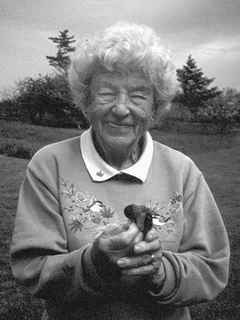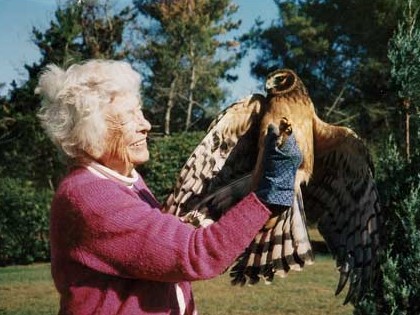A true citizen scientist, a subtle educator, a committed conservationist, a generous benefactor with a legacy that generations to come (both avian and human) will treasure.

Elise Lapham is among the elite of Rhode Island’s naturalists. She is a top notch scientist, an educator who has enlightened the lives of countless people over the years, and a conservationist who has dedicated her life to the preservation of wildlife habitat on Block Island. In fact, Block Island would be a completely different place without the foresight of Elise Lapham and her family.
In 1967, at the age of 55, Elise with the assistance of her daughter Helen, started to band birds during fall migration on Block Island. With this, the Block Island Banding Station was born. It has since become one the longest running banding operations in North America. The station is located on the Bluestone property, on Clay Head, and has been in operation continuously during spring and fall migration for 39 years. Amazingly, over 100,000 birds have been banded at the station, with over 162 species documented. At the age of 94, Elise’s insights into avian migration ecology continue. She has become one of the top ornithologists in the region, building a considerable body of knowledge about avian migratory ecology and documenting the importance of Block Island as a stopover site for neotropical migratory birds.
Elise Lapham is a true citizen scientist. Not only has she supported the work of many of the nation’s top ornithologists, but students and scientists from Brown University, the University of Rhode Island, the University of Southern Mississippi, and Cornell University have used her property as a base for their own studies or utilized the station’s computerized database for comparative research. She co-authored one of the definitive articles on avian migration in the region, “Landbird Migration on Block Island: Community Composition and Conservation Implications for an Island Stopover Habitat,” published in the Rhode Island Natural History Survey’s (2000) book, The Ecology of Block Island.

Elise is a subtle educator who is always available to discuss her avian research because she feels it is critical to educating children and adults about avian ecology and their habitat requirements. She has opened the doors of the banding station to hundreds over the years because she knows that once people have seen or held a bird in their hand and watched it flit away on its journey, they inevitably become strong advocates for avian conservation. School groups, birders, researchers, and eco-tour groups have visited the station. For over 30 years, the annual Audubon Society of Rhode Island’s birding weekend has included a stop at Elise’s home, where birders have been enthralled by the magic of birds in the hand.
Elise’s dedication and commitment to conservation set her apart from many other naturalists. Elise and David Lapham, her husband, who passed away in 1991, first ventured out to Block Island in 1951 for a vacation from their home in New Canaan, Connecticut. They enjoyed the island so much that after 10 years of renting vacation homes, they bought 140 acres near the northeast end of the island and built a home there. In the early 1980s, they took the bold step of working with The Nature Conservancy to protect their land from development by placing it into a permanent conservation easement, thus saving one of the jewels of Block Island from future development. The Laphams were stewards of their land, planting thousands of trees and flowers in the area and taking the selfless step of opening the Clay Head Trail to the public, offering impressive views of the Atlantic Ocean. They leveraged their own gifts of land to protect habitat across Block Island. We all owe a debt of gratitude to Elise, as well as to David and Helen, for their efforts to protect critical wildlife habitat on Block Island: it is a legacy that generations to come (both avian and human) will treasure.